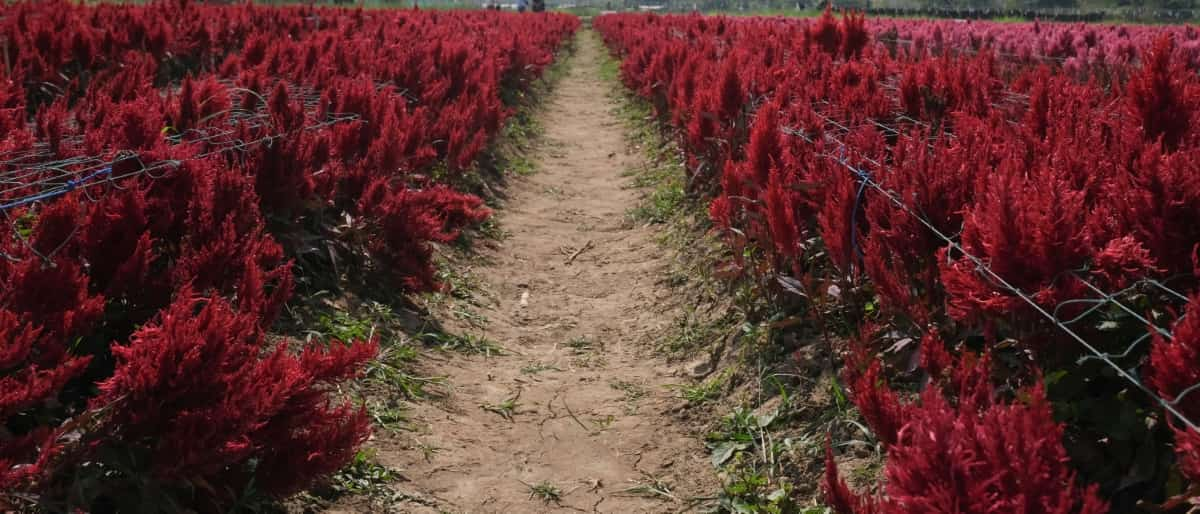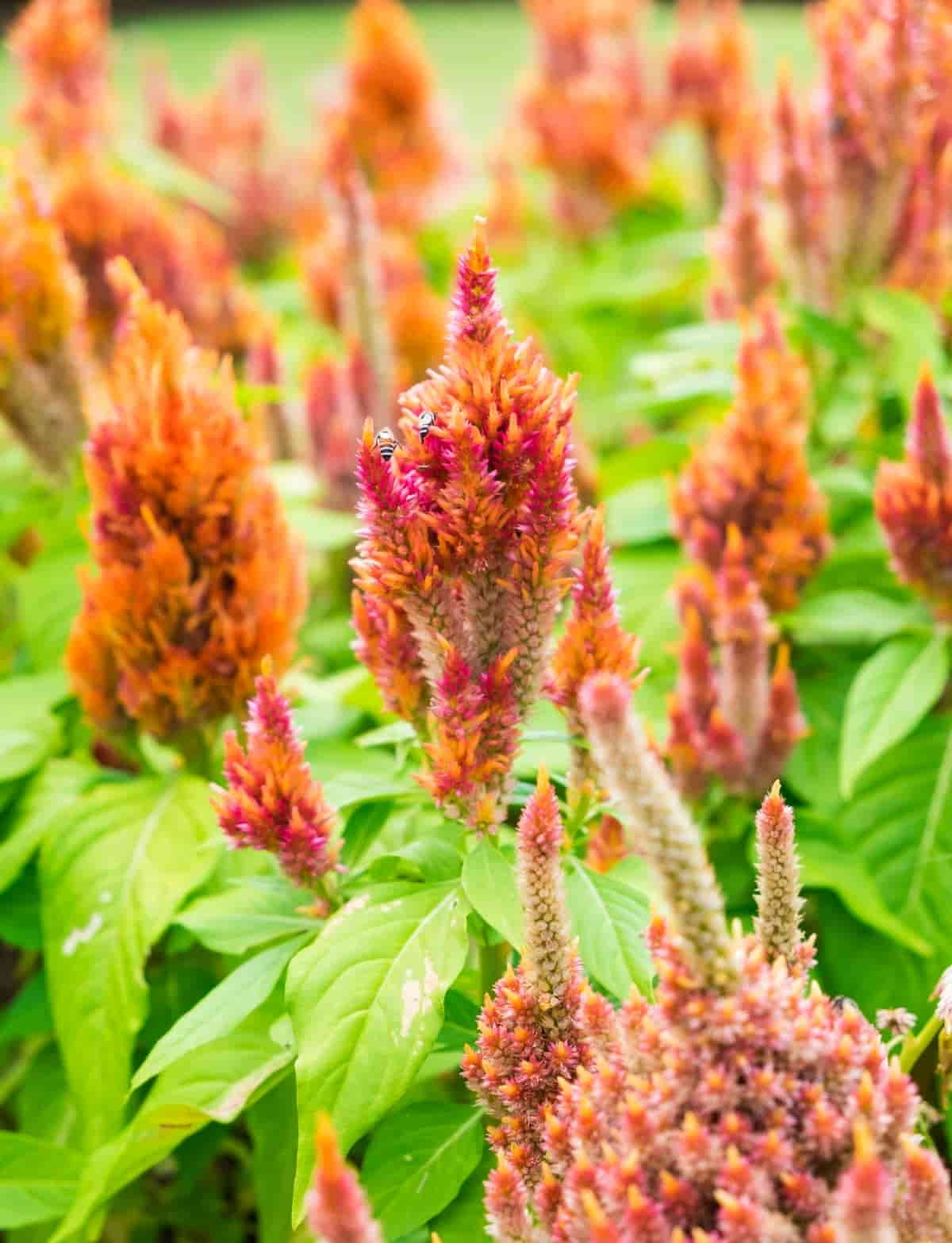The Cockscomb is an annual flowering plant that belongs to the family Amaranth. Cockscomb thrives in warm weather conditions with plenty of sunlight and well-draining soil.

How to Grow and Care for Cockscomb
Cockscomb Plant Information
- Botanical Name – Celosia argentea var. cristata
- Plant Type – Annual, perennial
- Sun Exposure – Full, partial
- Soil Type – Loamy, moist but well-drained
- Bloom Time – Summer, fall
- Flower Color – Red, pink, orange, yellow, white
- Hardiness Zones – 9-12, USA
- Native Area – South America, Central America, Asia, Africa
Light and Soil Requirement for Growing Cockscomb
- Cockscombs require full sun exposure, so select a spot that receives at least 6 hours of sunlight daily.
- Cockscombs prefer loose, well-draining soil that is slightly acidic with a pH level of 6 and 7.5. It’s important not to overwater the Cockscomb plant as they don’t like standing in water, which can cause root rot.
- If you’re planting your Cockscomb outdoors, loosen up the soil and add compost or aged manure before planting. This will improve drainage while adding nutrients for healthy growth.
- Use good quality potting mix combined with perlite or sand for improved indoor gardening or container planting drainage. Ensure your container has adequate drainage holes at the bottom to prevent waterlogging.
Propagating Cockscomb by Cuttings
- Select a healthy stem from the plant that you want to propagate. Make sure it has at least two or three nodes on it. Nodes are where leaves and branches grow from the stem.
- Next, use sharp scissors to make a clean cut just below one of the nodes. Be careful not to damage the node itself, as this is where new roots will sprout.
- Remove any flowers or leaves from the lower half of the cutting, leaving only those near the top intact.
- After that, dip the end of the cutting into rooting hormone powder before planting it in moist soil. This will encourage root growth and increase your chances of success.
- Keep your cutting in a partially shaded area until new growth appears, then gradually move it into brighter light over time.
How to Grow Cockscomb from Seed?
- Start your seeds around 8 to 10 weeks before your last frost date for planting. This will give them enough time to mature into sturdy plants that withstand outdoor conditions.
- Firstly, fill a container with soil and plant the seeds about an inch deep. Ensure you grow them in soil that drains well and is rich in nutrients. Cockscombs like full sun but also appreciate some shade.
- Once the seedlings have emerged, remove any covering and place them near a window where they can receive plenty of sunlight. You may also need to supplement with additional light if natural light isn’t sufficient.
- As your Cockscomb plants grow, ensure they get enough water without becoming waterlogged. You may also want to fertilize periodically using an all-purpose fertilizer designed for flowering plants. When it’s time to transplant your seedlings outdoors, choose a sunny spot with well-draining soil.
- If pests or diseases strike your plants, act quickly by removing affected leaves or treating them with an appropriate insecticide or fungicide. And finally, don’t forget about watering. Cockscombs need regular watering but should never sit in waterlogged soil. A good rule is always to keep the soil moist but not soggy.
Fertilizer to Encourage Cockscomb Growth and Flowering
- Fertilize your Cockscomb every two weeks during the growing season with an all-purpose fertilizer high in potassium.
- Fertilizing is an important part of caring for your Cockscomb. Using one high in phosphorus is best when choosing a fertilizer that helps promote healthy blooms. You can choose a slow-release fertilizer or mix a water-soluble fertilizer into your watering routine every 2 weeks.
- It’s important not to over-fertilize, as this can lead to burnt roots and foliage. Follow the instructions carefully on the package, and don’t exceed the recommended amount.
- By providing proper fertilization, you’ll help ensure that your Cockscomb stays healthy and vibrant throughout its growing season.
In case you missed it: How to Grow Artichoke in a Greenhouse: A Step-By-Step Guide for Seed to Harvest

Water Requirement for Cockscomb Plant Growth
- Water is an essential component for the growth and development of Cockscomb plants. These plants require regular watering to maintain their health and appearance.
- Overwatering the Cockscomb plant can lead to root rot and other problems. Therefore, it’s important not to let water accumulate at the base of the plant.
- Avoid getting water on the leaves of your Cockscomb, as this can encourage fungal diseases.
- During hot summer months or periods of droughts, increase watering frequency as needed by monitoring soil moisture levels daily using a finger test or a moisture meter.
Pests and Diseases Management for Growing Cockscomb Plants
- The most common pest that affects Cockscombs is aphids. To prevent aphids from infesting your Cockscomb, you should regularly inspect the leaves for signs of an infestation.
- Another pest that can damage your Cockscomb plant is spider mites. These little creatures thrive in hot, dry conditions and often leave webs on the undersides of leaves. You may need to use a natural insecticide or introduce predatory insects such as ladybugs into your garden to control spider mites.
- In addition to pests, several diseases, such as powdery mildew and root rot, can affect Cockscombs. Powdery mildew shows whitish-gray patches on the leaves, while root rot causes yellowing foliage or wilting stems.
- To prevent these issues from occurring or spreading throughout your garden bed, always ensure proper drainage for your soil by mixing sand with potting soil before planting seeds or seedlings in them. Also, avoid overwatering, which could lead to excessive moisture build-up, promoting fungal growth. Carefully watching pests and diseases is essential in maintaining healthy Cockscomb plants.
When and How to Harvest Cockscomb
You can start harvesting the flowers once they have fully bloomed and the petals have begun to dry out. Inspect your plant and choose which flowers you want to harvest. Look for blooms that are mature but still vibrant in color.
Next, use sharp scissors to cut the flower’s stem. Make sure not to damage any other buds or leaves on the plant. Once you’ve harvested your desired flowers, gather them in small bunches and tie them with string or rubber bands at their stems.
In case you missed it: How to Grow Geranium in a Greenhouse: A Step-by-Step Guide for Seed to Harvest

Conclusion
The Cockscomb is a beautiful addition to any garden space with its unique shape that adds charm and character to your outdoor area. Cockscomb flowers come in various colors ranging from red to orange and even pink. Providing ideal conditions will result in beautiful blooms that add to any garden or flower arrangement.
- Feed Your Flock for Less: Top 10 Tips to Save on Chicken Feed
- Ultimate Guide to Ossabaw Island Hog: Breeding, Raising, Diet, and Care
- Hatching Answers: The Top 10 Reasons Your Chickens Aren’t Laying Eggs
- Eggs and Economics: Breaking Down the Cost of Raising Backyard Chickens
- Defend Your Greens: Proven Methods to Keep Iguanas Out of Your Garden
- Ultimate Guide to Cinnamon Queen Chicken: A Comprehensive Guide for Beginners
- Ultimate Guide to California Tan Chicken: Breeding, Raising, Diet, Egg-Production and Care
- Ultimate Guide to Marsh Daisy Chicken: Breeding, Raising, Diet, and Care
- 10 Types of Chicken Farming Businesses You Can Start for Profits